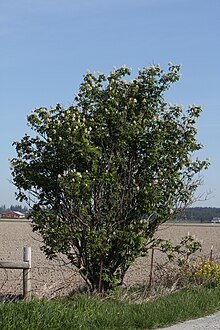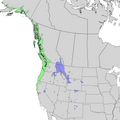bio.wikisort.org - Plant
Sambucus racemosa is a species of elderberry known by the common names red elderberry[2] and red-berried elder.[3]
| Sambucus racemosa | |
|---|---|
 | |
| Scientific classification | |
| Kingdom: | Plantae |
| Clade: | Tracheophytes |
| Clade: | Angiosperms |
| Clade: | Eudicots |
| Clade: | Asterids |
| Order: | Dipsacales |
| Family: | Adoxaceae |
| Genus: | Sambucus |
| Species: | S. racemosa |
| Binomial name | |
| Sambucus racemosa | |
| Subspecies[1] | |
Distribution and habitat
It is native to Europe, northern temperate Asia, and North America across Canada and the United States.[1] It grows in riparian environments, woodlands, and other habitats, generally in moist areas.[4]
Description
Sambucus racemosa is often a treelike shrub growing 2–6 m (7–20 ft) tall. The stems are soft with a pithy center.
Each individual leaf is composed of 5 to 7 leaflike leaflets, each of which is up to 16 cm (6+1⁄4 in) long, lance-shaped to narrowly oval, and irregularly serrated along the edges. The leaflets have a strong disagreeable odor when crushed.[5]
The inflorescence is a vaguely cone-shaped panicle of several cymes of flowers blooming from the ends of stem branches. The flower buds are pink when closed, and the open flowers are white, cream, or yellowish. Each flower has small, recurved petals and a star-shaped axis of five white stamens tipped in yellow anthers. The flowers are fragrant and visited by hummingbirds and butterflies.[4]
The fruit is a bright red or sometimes purple drupe containing 3 to 5 seeds.
Varieties and subspecies
- Sambucus racemosa subsp. kamtschatica — red elder, native to Northeastern Asia.[6]
- Sambucus racemosa var. melanocarpa — Rocky Mountain elder, native to the Western United States and Western Canada, including the Rocky Mountains and Sierra Nevada.[7][8][9]
- Sambucus racemosa subsp. pubens — American red elder, native to Eastern North America
- Sambucus racemosa subsp. racemosa — European red elder.[10]
- Sambucus racemosa var. racemosa — Pacific red elderberry.[11][12][13]
- Sambucus racemosa subsp. sibirica — red elder, native to Siberia.[14]
- Sambucus racemosa subsp. sieboldiana — Japanese red elder
Uses
The stems, roots and foliage are poisonous, and the berries can be toxic or cause nausea if eaten raw.[4]
Medicinal plant
It has been used as a traditional medicinal plant by Native Americans, including the Bella Coola, Carrier, Gitksan, Hesquiaht, Menominee, Northern Paiute, Ojibwa, Paiute, Potawatomi, Tlingit, and Haida peoples.[4][15] The uses included as an emetic, antidiarrheal, cold and cough remedy, dermatological and gynecological aid, and a hemostat.[15]
Food
The fruits are reportedly safe to eat[16] when cooked, but are potentially poisonous when raw. They were cooked in a variety of recipes by indigenous peoples, including by the Apache, Bella Coola, Gitxsan, Gosiute, Makah, Ojibwa, Quileute, Skokomish, Yurok peoples.[4]
The fruits are popular with birds, who also distribute the seeds.[17] The flowers attract butterflies and hummingbirds.[4]
Cultivation
Sambucus racemosa is cultivated as an ornamental plant, for use as a shrub or small tree in traditional and wildlife gardens, and natural landscape design projects.[4]
Cultivars
Cultivars in the nursery trade include:
- Sambucus racemosa 'Black Lace' — burgundy foliage[18]
- Sambucus racemosa 'Lemon Lace' — golden yellow and green foliage[19]
- Sambucus racemosa 'Lemony Lace' — golden green foliage, with red new growth[20]
- Sambucus racemosa 'Sutherland Gold' — green foliage, with bronze new growth:[21] it has received the Royal Horticultural Society's Award of Garden Merit.[22][23]
Images
- Fruit (Mount Baker-Snoqualmie National Forest)
- Leaves and buds of the red elderberry
- Inflorescence and foliage
- Clusters of berries
 Natural range of S. racemosa var. racemosa (green) and var. melanocarpa (blue) in western North America.
Natural range of S. racemosa var. racemosa (green) and var. melanocarpa (blue) in western North America.
References
- Sambucus racemosa was originally described and published in Species plantarum 1:270. 1753. "Sambucus racemosa". Germplasm Resources Information Network (GRIN). Agricultural Research Service (ARS), United States Department of Agriculture (USDA). Retrieved December 8, 2012.
- USDA, NRCS (n.d.). "Sambucus racemosa". The PLANTS Database (plants.usda.gov). Greensboro, North Carolina: National Plant Data Team. Retrieved 28 October 2015.
- BSBI List 2007 (xls). Botanical Society of Britain and Ireland. Archived from the original (xls) on 2015-06-26. Retrieved 2014-10-17.
- "Sambucus racemosa". Native Plant Database. Lady Bird Johnson Wildflower Center, University of Texas at Austin.
- Trees, Shrubs, and Woody Vines of North Carolina: Red Elderberry (Sambucus racemosa var. pubens)
- "Sambucus racemosa subsp. kamtschatica". Integrated Taxonomic Information System.
- "Sambucus racemosa var. melanocarpa". Calflora. Berkeley, California: The Calflora Database.
- USDA, NRCS (n.d.). "Sambucus racemosa var. melanocarpa". The PLANTS Database (plants.usda.gov). Greensboro, North Carolina: National Plant Data Team.
- Jepson Flora Project (ed.). "Sambucus racemosa var. melanocarpa". Jepson eFlora. The Jepson Herbarium, University of California, Berkeley.
- "Sambucus racemosa subsp. racemosa". Integrated Taxonomic Information System.
- "Sambucus racemosa var. racemosa". Calflora. Berkeley, California: The Calflora Database.
- USDA, NRCS (n.d.). "Sambucus racemosa var. racemosa". The PLANTS Database (plants.usda.gov). Greensboro, North Carolina: National Plant Data Team.
- Jepson Flora Project (ed.). "Sambucus racemosa var. racemosa". Jepson eFlora. The Jepson Herbarium, University of California, Berkeley.
- "Sambucus racemosa subsp. sibirica". Integrated Taxonomic Information System.
- University of Michigan at Dearborn: Native American Ethnobotany for Sambucus racemosa
- Fagan, Damian (2019). Wildflowers of Oregon: A Field Guide to Over 400 Wildflowers, Trees, and Shrubs of the Coast, Cascades, and High Desert. Guilford, CT: FalconGuides. p. 16. ISBN 978-1-4930-3633-2. OCLC 1073035766.
- Pojar, J. & A. MacKinnon. (1994). Plants of the Pacific Northwest. Lone Pine Publishing. ISBN 1-55105-042-0
- Proven Winners.com: Sambucus racemosa Black Lace
- Wayside Gardens.com: Sambucus racemosa 'Lemon Lace'
- Proven Winners.com: Sambucus racemosa Lemony Lace
- Fine Gardening Magazine: Sambucus racemosa Sutherland Gold
- "RHS Plant Selector - Sambucus racemosa 'Sutherland Gold'". Retrieved 5 March 2021.
- "AGM Plants - Ornamental" (PDF). Royal Horticultural Society. July 2017. p. 94. Retrieved 28 October 2018.
External links
- Calflora
- Jepson eFlora, The Jepson Herbarium, University of California, Berkeley
- "Taxon Sambucus racemosa profile". Burke Museum. Herbarium. University of Washington.
- Sambucus racemosa in the CalPhotos photo database, University of California, Berkeley
На других языках
- [en] Sambucus racemosa
[es] Sambucus racemosa
Sambucus racemosa, el saúco rojo, es una especie de Sambucus originario de Europa, el Asia templada y el norte y el centro de Norteamérica.[1] Crece en los medios ribereños, bosques y otros hábitats, generalmente en zonas húmedas.[2][ru] Бузина красная
Бузина́ кра́сная, или бузина́ обыкнове́нная, или бузина́ кисти́стая.mw-parser-output .ts-Переход img{margin-left:.285714em} (лат. Sambúcus racemósa), — листопадное древесное растение, известное своими красными плодами и характерным неприятным запахом листьев и цветков; вид рода Бузина (Sambucus) семейства Адоксовые (Adoxaceae) (этот род иногда включают в семейство Жимолостные или выделяют в отдельное семейство Бузиновые). Описано несколько инфравидовых таксонов.Другой контент может иметь иную лицензию. Перед использованием материалов сайта WikiSort.org внимательно изучите правила лицензирования конкретных элементов наполнения сайта.
WikiSort.org - проект по пересортировке и дополнению контента Википедии




